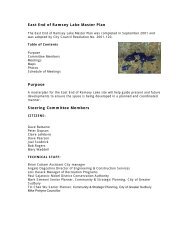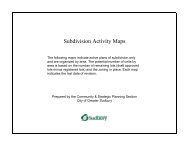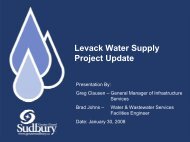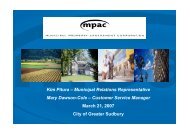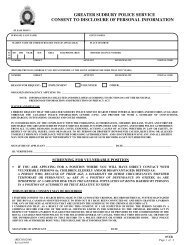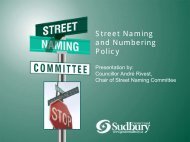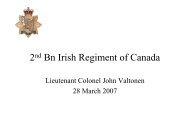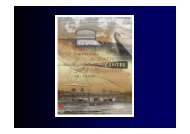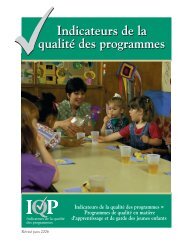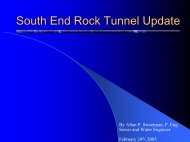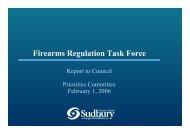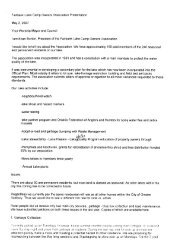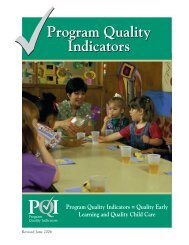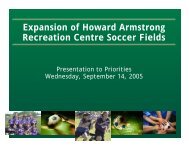City of Greater Sudbury Transportation Study Report
City of Greater Sudbury Transportation Study Report
City of Greater Sudbury Transportation Study Report
You also want an ePaper? Increase the reach of your titles
YUMPU automatically turns print PDFs into web optimized ePapers that Google loves.
4.6. Model Validation<br />
Validation <strong>of</strong> the model involves comparisons <strong>of</strong> model simulations for a base year with<br />
observed data collected in that base year. In the case <strong>of</strong> the <strong>Greater</strong> <strong>Sudbury</strong> model, the<br />
observed data consists <strong>of</strong> the household survey data discussed in Section 3.1, which is<br />
summarized in a trip table, and count data collected from <strong>Greater</strong> <strong>Sudbury</strong> and the MTO,<br />
which is summarized, on a screenline basis.<br />
The p.m. peak hour survey data is compared to the p.m. peak hour simulated trips on an<br />
aggregated trip table basis with the aggregation being on the former Municipalities. A<br />
comparison <strong>of</strong> the observed and simulated<br />
trips is shown in Figures 4.6.1 and 4.6.2.<br />
Figure 4.6.1 shows a direct comparison<br />
between observed and simulated trips while<br />
Figure 4.6.2 shows a comparison <strong>of</strong> the<br />
natural log (LN) <strong>of</strong> the observed trips with the<br />
LN <strong>of</strong> the simulated trips. The R-square<br />
indicates that the model is producing<br />
reasonable estimates <strong>of</strong> travel between the<br />
former municipalities.<br />
Comparisons <strong>of</strong> simulated p.m. peak hour<br />
volumes with traffic counts at the screenline<br />
level are shown in Table 4.6.1. Also shown is<br />
Observed<br />
Figure 4.6.1 Observed vs. Simulated P.M. Peak Hour Autos<br />
14000<br />
12000<br />
10000<br />
8000<br />
6000<br />
4000<br />
2000<br />
0<br />
0 5000 10000 15000<br />
Simulated<br />
y = 0.9999x + 10.684<br />
R 2 = 0.9961<br />
Observed<br />
Linear (Observed)<br />
the screenline summary <strong>of</strong> the home interview survey data. The “inbound” represents trips<br />
traveling towards the center <strong>of</strong> the <strong>City</strong> while the “outbound” represents trips traveling away<br />
from the center <strong>of</strong> the <strong>City</strong>. The household survey was geo-coded to the traffic zone level<br />
then assigned to the base year road network then summarized by screenline. In some cases<br />
the count data was lower than the model simulation and the results <strong>of</strong> the household survey.<br />
The p.m. peak hour count data was acquired from <strong>Greater</strong> <strong>Sudbury</strong> and from the MTO.<br />
Some <strong>of</strong> these counts were in the form <strong>of</strong> intersection counts collected manually while others<br />
were collected by Automatic Traffic Recorders (ATR) as part <strong>of</strong> the AADT count program.<br />
Counts were not always available for recent<br />
years, which meant that prior counts had to<br />
be used. Also, in a few instances the p.m.<br />
peak hour counts had to be estimated from<br />
the AADT counts. Also, some <strong>of</strong> the<br />
screenlines cross minor roads for which<br />
counts were not available. Ideally, for model<br />
validation purposes, the count data should be<br />
collected using the same method and the<br />
counts should all be done at the same time.<br />
The lack <strong>of</strong> consistency in terms <strong>of</strong> timing and<br />
the fact that some <strong>of</strong> the counts had to be<br />
estimated makes it difficult to use for model<br />
validation purposes. In spite <strong>of</strong> this,<br />
Figure 4.6.2 LN(Observed) vs LN(Simulated) P.M. Peak<br />
Hour Autos<br />
0<br />
0<br />
-2<br />
2 4 6 8 10<br />
y = 1.0198x - 0.2318<br />
R 2 = 0.8962<br />
comparisons at the screenline level between the model simulation, the observed data from<br />
the household survey, and the count data indicates that the model has been well calibrated<br />
and validated. Figure 4.6.3 illustrates the screenlines used for the model validation.<br />
LN(Observed)<br />
10<br />
8<br />
6<br />
4<br />
2<br />
Ln(Simulated)<br />
LN(Observed)<br />
Linear (LN(Observed))<br />
CITY OF GREATER SUDBURY<br />
OFFICIAL PLAN BACKGROUND REPORT<br />
September 2005 Page 49



